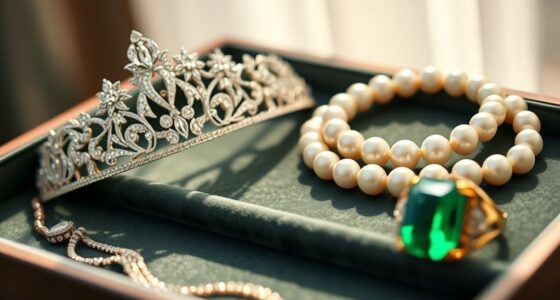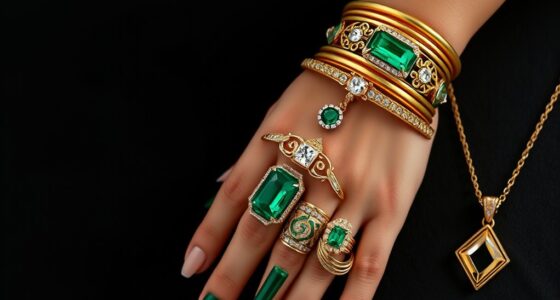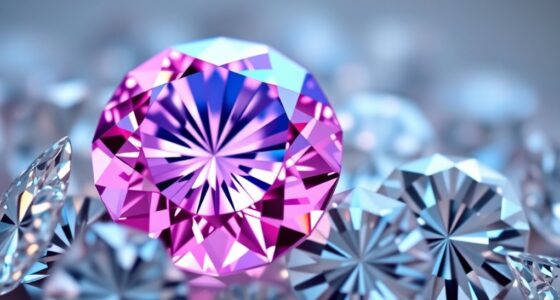When deciding between a cabochon and a faceted gemstone, consider the jewelry’s style and what highlights the stone’s best features. Opt for a cabochon if you want to showcase internal patterns, rich colors, or unique inclusions, creating a bold or subtle look. Choose a faceted stone when you desire brilliance, sparkle, and a more modern appearance. If you want to explore the best choices for your jewelry designs, keep exploring the differences and advice further.
Key Takeaways
- Choose cabochons to highlight internal features, patterns, or rich colors, especially for stones like opal, turquoise, or moonstone.
- Opt for faceted gemstones when seeking maximum brilliance, sparkle, and a modern, elegant appearance.
- Use cabochons for bold statement pieces or when emphasizing the stone’s natural beauty and internal characteristics.
- Select faceted cuts to enhance light reflection, making the gemstone appear more luminous and visually striking.
- Consider the jewelry design style and desired aesthetic—cabochons for subtle, natural looks; faceted for shimmering, contemporary designs.

When choosing between cabochon and faceted gemstones, understanding their distinct cuts can considerably impact your jewelry’s appearance and value. The way a gemstone is cut influences how it interacts with light, its overall aesthetic, and how it complements your design. As you explore these options, it’s essential to consider gem cutting techniques and jewelry design considerations to guarantee your selection aligns with your style and purpose.
Cabochons are polished, smooth stones without facets, typically rounded or oval with a domed top and flat bottom. They highlight a gemstone’s color, pattern, and unique inclusions, making them ideal for stones with interesting internal features like opals, turquoise, or moonstone. Since cabochons don’t rely on facets to reflect light, they emphasize a stone’s natural beauty rather than brilliance. When choosing cabochons, you focus on the stone’s inherent qualities, which can be accentuated through specific gem cutting techniques like shaping and polishing. These techniques require skill to maximize the stone’s visual appeal and guarantee a smooth, even surface. Knowing your jewelry design considerations, such as whether you want a bold statement piece or a subtle accent, helps determine if a cabochon fits your vision. Additionally, understanding the gem cutting techniques involved can help you select the best stone for your desired effect.
Polished, smooth cabochons highlight natural color and patterns without facets, perfect for internal features like opals and turquoise.
Faceted gemstones, in contrast, are cut with multiple flat surfaces, or facets, that are precisely arranged to reflect light internally and externally. This cut enhances the gemstone’s brilliance and sparkle, making it perfect for stones like diamonds, sapphires, and rubies. The gem cutting techniques involved in faceting are intricate, requiring precision to ensure symmetry and optimal light performance. When selecting faceted stones, consider how their cut complements your jewelry’s style—whether you prefer a classic, sophisticated look or something more modern and eye-catching. Faceted cuts can also influence the perceived size of a gemstone; well-cut facets can make a smaller stone appear larger and more luminous. Your jewelry design considerations, including the setting style and overall aesthetic, play a crucial role in choosing a faceted gem.
Ultimately, your decision hinges on the type of visual impact you want to create. If you’re drawn to the natural beauty, patterns, and rich colors of a stone, a cabochon might be the right choice. If you prefer brilliance, sparkle, and a sense of elegance, then a faceted gemstone will serve you better. Both cuts require specific gem cutting techniques and align with different jewelry design considerations, so understanding the differences will help you pick the perfect gemstone to elevate your jewelry collection.
Frequently Asked Questions
How Do I Identify if a Gemstone Is Cabochon or Faceted?
To identify if a gemstone is cabochon or faceted, look at its surface and cut symmetry. A cabochon has a smooth, rounded surface without facets, giving it a polished, domed appearance. A faceted gemstone, on the other hand, features multiple flat surfaces (facets) that reflect light brilliantly. You’ll notice sharp edges and symmetrical cuts on a faceted stone, while a cabochon’s surface is even and curved.
Are Cabochon or Faceted Stones More Durable for Everyday Wear?
Faceted stones generally offer better durability for everyday wear because their polished surfaces resist scratches better. However, cabochon gems can also be durable if made from hard materials like opal or turquoise. Consider durability considerations and maintenance tips; avoid exposing softer stones to harsh impacts or chemicals. Regular cleaning and careful handling help maintain both types of stones, ensuring they stay beautiful over time.
Can a Gemstone Be Both Cabochon and Faceted?
Yes, a gemstone can be both cabochon and faceted, though it’s rare. You’d be surprised how gemstone processing and cutting techniques can transform a single stone into multiple styles. Usually, specialists choose one method to highlight specific qualities. Combining both requires skill and precision, creating a unique gem that’s both smooth and shimmering. If you’re lucky, you might find a piece that showcases both worlds—an intriguing blend of artistry and craftsmanship.
Which Cut Enhances the Color Intensity Better?
You’ll find that a faceted cut enhances color intensity more effectively than a cabochon. The cut precision of faceting creates multiple reflective surfaces, amplifying the gemstone’s natural color and brilliance. This makes the color appear richer and more vivid. If you want maximum color enhancement, opt for a well-cut faceted gemstone, as the precise facets work together to intensify and showcase the stone’s vibrant hues.
How Does the Cut Type Affect the Gemstone’s Value?
The cut type is the gemstone’s personality, shaping its value like a sculptor’s touch. A faceted cut often boosts the price impact due to its brilliance and rarity considerations, making it more desirable and valuable. Conversely, cabochons tend to be less expensive but can highlight unique color and clarity. Your choice affects rarity and market appeal, ultimately influencing the gemstone’s worth and how much you’ll pay or sell.
Conclusion
So, now you’re a gemstone connoisseur, armed with the knowledge to pick between a glossy cabochon or a dazzling faceted stone. Just remember, whether you choose smooth and understated or sparkly and showy, it’s all about your style—because nothing says “I know what I’m doing” like confidently tossing a gemstone into your jewelry collection. Happy gem hunting, and don’t forget: in the world of stones, there’s no wrong choice—only fabulous excuses to buy more!









